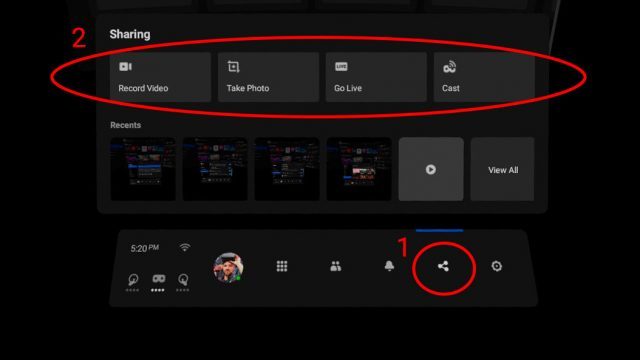Quest 2 has simple built-in video capture capabilities. In this article you’ll see how to use them and, for advanced users, you’ll learn how to increase the quality of the videos captured on Quest 2 and how to transfer videos to your computer.
Record, Stream, or Cast Your VR Gameplay on Quest 2
With something as cool as VR, it’s natural to want to share the experience. Luckily Quest 2 has many sharing options built right in. You can record videos of your gameplay, take screenshots, cast a video to your phone or TV, or even stream to viewers online. Here’s how:
- In your headset, bring up the Quest menu by pressing the Oculus button on your right controller. Find the Share section.
- At the top of the Share menu you can now choose between Record Video, Take Photo, Go Live, and Cast.
If you have set up Quest Voice Commands, you can even say “record video,” “take screenshot,” “cast,” or “stream” to quickly do any of these actions in the midst of gameplay.
‘Cast’ allows you to stream video of your experience devices on your local network. You can cast to your smartphone through the Oculus smartphone app or to your PC by visiting oculus.com/cast. You can also cast to any compatible devices on your network like a TV with Chromecast.
‘Go Live’ allows you to stream your Quest 2 experience out to the internet, but unfortunately you can only stream to Facebook.
Recorded videos and captured photos are stored on the headset, you can access them by clicking the ‘View All’ button in the Share menu. You can also plug Quest 2 into a computer to download videos for editing and sharing (see section further below).
Increase Capture Quality on Quest 2 Recordings (advanced)
The default Quest 2 capture settings are fine for sending quick clips to friends, but painfully low quality for doing much else. If you’re an advanced user, it’s possible to increase both the resolution and framerate of Quest 2 recordings. A PC will be required.
The commands below will also work on the original Quest, but the values may be too high for the headset to handle; tweak them down if you run into performance issues during capture.
- Install SideQuest via these instructions.
- Plug the headset into your PC.
- On the SideQuest menu bar, click Run ADB Commands > Custom Command.
- Input the following commands one line at a time, and press ‘Run Command’ for each:
- adb shell setprop debug.oculus.capture.width 1440
- adb shell setprop debug.oculus.capture.height 1080
- adb shell setprop debug.oculus.fullRateCapture 1
- adb shell setprop debug.oculus.capture.bitrate 30000000
- Once complete, you can unplug your headset and use the built-in ‘Record Video’ function (see the top of the article) to capture higher quality video with the new settings.
- Resetting your headset will return to default settings
Tweaking Capture Settings
In the above steps we set the Quest 2 capture resolution to 1,440 × 1,080, the capture frame rate to 72 FPS, and the capture bitrate to 30,000,000.
For reference, the default values are 1,024 × 1,024 resolution, 30 FPS framerate, and 5,000,000 bitrate
The settings above can be tweaked based on your needs, but be warned that if you push them too high you can cause performance issues both in the game you’re capturing and in the captured video itself (stuttering and encoding artifacts).
The settings we shared above are based on a balance of quality and performance, and we’ve found they work well for most games. However, if you’re going to be capturing a lot of footage, we’d highly recommend you first test against any new game to ensure the captured output is error free.
Aspect Ratio
One important thing to note is that the resolution options we set above also control the aspect ratio of the Quest 2 video capture. The default aspect ratio is 1:1 (square), while our settings above are a bit wider at 1.33:1, which gives the crop a bit more room to breath on the sides.
If you’d like a traditional widescreen 1.77:1 (16:9) crop, 1,920 × 1080 will give you the shape you’re after. However, 16:9 tends to feel ‘cut off’ on the top and bottom compared to what the view feels like against the headset’s field of view.
Quelle:




